
11 minute read
GENERATION WANDERLUST Namibia on a student budget
student budget Namibia on a

Hi, my name is Charene and I am addicted to travel magazines. The glossy covers and saturated double-page spreads have tickled my fancy ever since I was little. It most certainly started with my parents’ loyal monthly purchase of Go! magazine, which I would ooh and aah over long before I could read. See, I’m a serial dreamer driven by beautiful images of all the places I plan to visit before I kick the bucket. Unfortunately, I currently find myself on a humbling student budget. That means travel, if not on my parents’ expense, simply put, ain’t gonna happen. In Namibia specifically, travel has become a rather expensive sport if you don’t earn in euros or US dollars. So here is my guide to exploring my homeland on half a paycheck rather than half of your life’s savings.
BIG PAN BREAKFAST (From Antoinette De Chavonnes Vrugt's My Hungry Heart)
Use a large frying pan, heat oil and sauté the onions until golden. Add bacon pieces, garlic and pork sausages to pan and cook until brown.

Add green pepper and button mushrooms. Continue to stirfry until soft. Add baked beans and chopped tomatoes. Season to taste, add sugar and allow to simmer for a few minutes.
With the back of a soup ladle, make hallows in the sauce and break an egg into each hole. Cover the pan with a lid or foil and cook until the eggs are done.
Sprinkle grated cheese over the breakfast pan and serve with white bread, vetkoek or farmstyle health bread. 2 large onions, sliced 20 ml cooking oil 3 cloves of garlic, crushed 125 g bacon pieces (or bacon rashers diced) 250 g pork sausages cut into pieces 1 green pepper diced 100 g button mushrooms, sliced 1 x 410 g chopped tomato 1 x 410 g tin baked beans in tomato sauce 100 g grated cheddar cheese 6-8 eggs Pinch of salt Freshly ground black pepper and a pinch of sugar to balance the acidity of the tomato
CUTTING BACK ON BOOZE SAVES YOU A SH*TTON I recently did Sober October. Not because I think I have a problem, because I don’t, but because my boyfriend was doing it and I am very, very competitive. I began the challenge on the 7 th of October because I had attended Rocking The Daisies the weekend prior and you cannot get away not drinking Jägermeister. It’s obligatory and any Namibian knows you do not reject a shot of the herbal goodness.
Drinking in the student town of Stellenbosch is not a spectator sport - you either get on the bandwagon or you stay home. But I was not going to lock myself in my duplex digs and miss out on the fun. #FOMO
What I realised one fateful Thursday night - Stellenbosch also does not abide by regular “drinking days” - when the bill arrived and I owed a mere R50 (including tip), was that a lifestyle of drinking soda water is significantly more affordable. Even in a student town where booze is alarmingly cheap, soda water is cheaper. I saved a lot of money (which I ended up spending on Woolworths grapes) but nonetheless, cutting back on alcoholic beverages, albeit challenging, saves you a pretty penny. And those add up to a considerable amount - especially when you’re looking at a 5/7 drinking week. Your wallet (and your liver) will thank you.
PREPARE YOUR OWN MEALS It is very, and I mean VERY, tempting to dive headfirst into the food scene that is Namibia. With such a diverse culture and corresponding selection of food, I don’t blame you for wanting to indulge in Kapana, Eisbein and Mopane Worms. And you should without a doubt experience them - in moderation. But preparing your own meals whilst on your adventure is going to
save you a lot of extra cash. Luckily you don’t have to sacrifice the authentic Namibian experience: pick up My Hungry Heart by Antoinette de Chavonnes Vrugt, which comprises all the Namibian recipes you need. Yes, you will have to wash the dishes, but home-cooked meals - or even better, meals cooked on an open fire - add a whole new facet to your adventure (and cooking repertoire.)
YOU DON’T NEED A MASSIVE 4X4 Namibia notoriously has some of the most hectic dirt roads. And although a lekker Land Rover will certainly help with the gravel travel, it is not a prerequisite to exploring the coolest places. These vehicles are undoubtedly rugged but also famed for being very heavy on fuel and rather expensive to hire. I drive a 1998 Toyota Rav. My father calls it a Dinky Toy because it is small, slow and very sassy. But regardless, it takes me places - at 80km/h with the aircon off - because it is still a four-wheeldrive vehicle. Some of my family members from abroad have braved the Namibian landscape with two-wheel-drive sedan cars and still effortlessly reached their destination. In one piece (unlike a Landy.) Let’s be honest, if you’re travelling on a student budget you’re not going very far, so a smaller rental will certainly get you there. You might have to squeeze your gear and sacrifice legroom but you’ll be saving so much money you won’t be bothered.
JUST ROUGH IT Within our borders is a collection of luxury lodges bold enough to lure even Angelina Jolie. But we can’t afford those, no matter how much soda water we drink. Luckily, Namibia also comprises some spectacular camping facilities. If you choose wisely, you could find yourself glamping instead of camping. Proper ablution facilities, cool, sparkling pools and built braais
OUR GENERATION WANDERLUST SPECIAL SPOTS: Waterberg walk Camping along the Kwando River Spitzkoppe Arch Epupa Falls Fun near the Desert Grace Naukluft Pools Sossusvlei Waterfall swim at Warmquelle

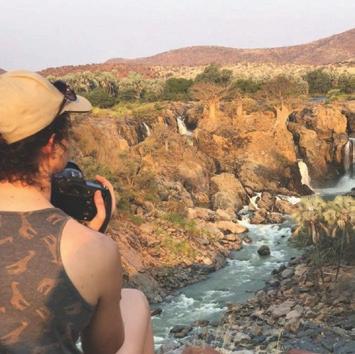
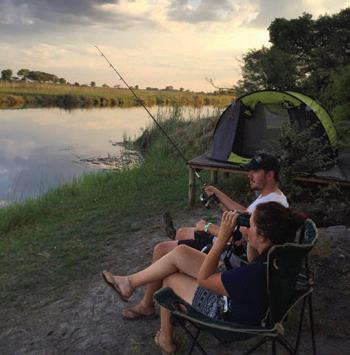

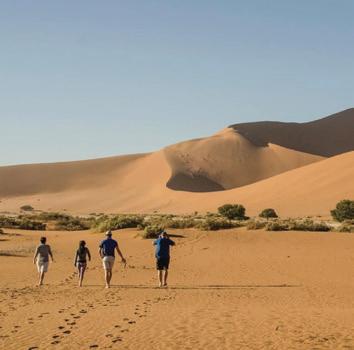
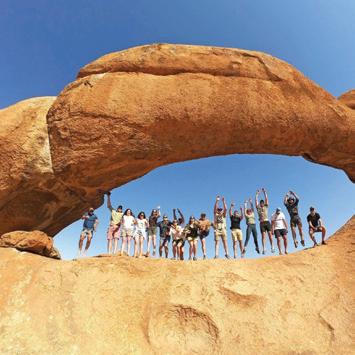


are just some of the amenities you can expect. When I was younger and my parents were brave enough to take us on camping trips, my sister and I would spend a solid sixty minutes scouting for the best spot to pitch our tent, and then have a massive argument while doing so. In later years we discovered that singing Bohemian Rhapsody is the only way to avoid the squabbles, and lo and behold - we can now pitch a tent in six minutes flat while staying on key. I have much fonder memories of camping terrains than 4-star, air-conditioned lodge suites.
SETTING DAILY SPENDING LIMITS When you’ve gathered all the money you’ve saved (thanks, soda water), it’s essential that you give yourself a guideline of how much you can afford to spend each day of your long
awaited trip. There is a whole bunch of things to keep in mind when setting up this budget, including the nifty sedan’s rental and petrol money, as well as the small fee they charge for campsites. Once you have the non-negotiable expenses sorted, you may begin adding a couple of dollars for the food you’ll be cooking yourself and the soda water you’ll be taking along. I’m ashamed to admit that I have lived off baked potatoes (a campfire staple) for a solid week. And although it’s not nearly as glamorous as the grapefruit diet, it’s cheap and easy, and honestly - who doesn’t love potatoes?
Foregoing luxury at the expense of simply travelling is probably the most rewarding sacrifice. Because at the end of the day, whether you like to admit it or not, you’re perhaps going to treasure the memories of your limited legroom far more than those of your air-conditioned accommodation. TNN
you should ask about your next TPMS (tyre pressure measure system) So you consider installing a TPMS on your vehicle. Here are 10 questions you should ask before making the final decision: 10 QUESTIONS
1. IS IT EASY TO INSTALL? • Internal sensors vs external sensors. • Internal sensors are installed inside the tyre, which means they are protected from theft. But at the same time, when you install the system you need the help of a tyre repair shop. Each tyre has to be dismantled for the sensor to be installed inside the tyre. The same has to be repeated at some time in the future, the sensor battery or the sensor (if the battery is not replaceable) needs changing. • External sensors are installed on the valve instead of the valve cap. This is typically a five minute DIY installation. You also have the option to install an anti-theft
device that will protect the sensor from vandalism.

A TPMS has the purpose to increase driving safety and the reliability of your vehicle, as not to get stranded on the roadside. In order to achieve this, it is necessary to install it correctly. A manufacturer who takes this seriously will provide several ways of installation support: Videos: Explainer videos that will show installation and setup step by step can solve problems and answer questions that might arise during installation. User Manual: A user manual will explain in detail and in your own language all the details of the system down to the package contents and conditions of warranty. Technical hotline: Ideally there is also a phone number available if you have any questions or doubts.
2. IS IT EASY TO USE? A TPMS is a technical system that can also be used by laymen. What you want is information about the current status (pressure, temperature) of your tyres plus a warning (audible, visible) in case something is happening that might lead to a problem. You should not be expected to have a PhD in order to understand the complexity of settings or system functions.
3. HOW ABOUT READABILITY? While driving, you have a lot more things to do than babysit your TPMS. The TPMS therefore should be easily accessible and also easy to comprehend. If you have a display that shows all tyre pressures in big letters, so that you can read and grasp them in one short glance, this is the ideal situation. Having to tap a button to activate the display or to flip sequentially through the tyre information is more of a distraction (that might lead to destruction) and reduces driving safety rather than improving it.
4. DOES IT PROVIDE ADJUSTABLE WARNING THRESHOLDS? You may want to operate your vehicle using different tyre pressures for different driving situations. So adjusting warning thresholds should not be complicated but easy to do. A clearly structured settings menu will make changing the warning thresholds swift and easy. It should not be more than pressing a few buttons.
5. IS THE SENSOR ROBUST ENOUGH FOR THE INTENDED USE, I.E. IS THE SENSOR CASE MADE OF METAL? TPMS sensors are exposed to all weather conditions and also to all kinds of road conditions. In addition there is mechanical stress from the tyre rotation. With every bump that the tyre gets, the sensor gets a bump of the same magnitude when making contact with the rim – if sensors are installed on rubber valves. A plastic sensor case may withstand this mechanical wear for a certain time, but in the long run a metal sensor case shows a clear advantage. Rugged and robust? Metal will go much farther.
6. ARE SENSOR BATTERIES REPLACEABLE? Sensors are electronic devices and they need electrical energy coming from a battery. Make sure this battery is replaceable, and that replacing a battery is an easy task, too. Otherwise prepare for replacing all your sensors after 4-5 years, which will cost as much as buying a new system. A replaceable battery might last just two years or even only one year, but three or even five batteries will be much cheaper than a new sensor. Consider the cost of ownership!
7. ARE SPARE PARTS AVAILABLE? Check with your future TPMS supplier. A TPMS is a technical system and an automotive accessory. As such it will see wear and tear and things may break eventually – not a big thing if your supplier has the necessary spare parts. A display holder is broken? You lost a cigarette lighter adapter cable? This is no reason to throw away the system. The same goes for a defective sensor.

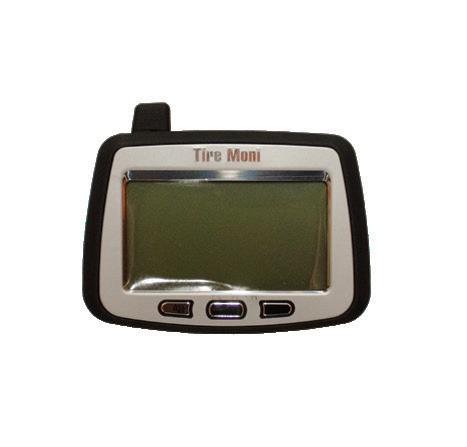
8. WILL SPARE PARTS BE AVAILABLE IN 10 YEARS? How long do you generally plan to drive a car? This is ideally how long your TPMS should serve you. Since it is a retrofit system, why not take it along from this car to your next one. Easy, if you have a reliable supplier who can still support you with spare parts. TireMoni has a history of doing just that.
9. IS SERVICE AVAILABLE? Sometimes things wear and break that you cannot fix yourself. Air might leak if a sensor gasket is worn down. Your display might fall and the glass breaks. In this case a reliable supplier can offer his service and repair your system.
10.WHAT IS THE PRICE OF THE SYSTEM? Considering all the questions above, a low price system is in the long run often more expensive than an adequately priced system of excellent quality that comes with a decent level of service and support. TNN
Tyre Pressure Monitor TM-160 (TireMoni 6-Wheel) N$ 3782 Product code: 9131002039
Tel: +264 61 295 6000 Email: info@cymot.com www.cymot.com












